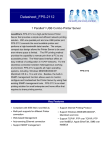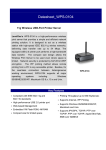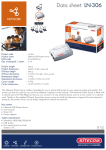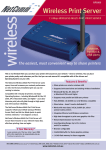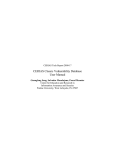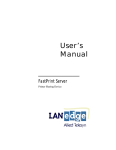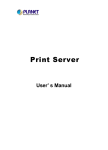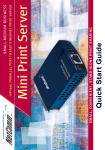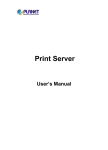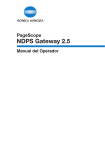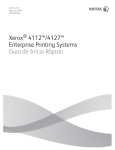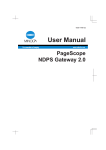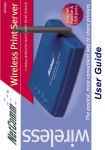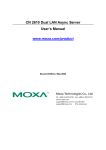Download LanEdge FastPrint Quick Install Guide
Transcript
LanEdge Print Server Quick Install Guide This Quick Install Guide contains brief instructions only, and is intended for experienced users or Network Administrators. If this information is insufficient, please refer to the full User Manual on the CD-ROM. Table of Contents Quick Install Guide............................................................ 1 Physical Installation........................................................... 1 Setup - Overview............................................................... 1 Windows Peer-to-Peer ....................................................... 2 AppleTalk ......................................................................... 9 Windows NT Server (TCP/IP) ......................................... 10 NetWare 3.x, 4.x Print Server Mode................................. 11 Using NDPS (NetWare 5)................................................ 12 Unix................................................................................ 16 Physical Installation 1. Connect the LAN cable to the Print Server. If both 10BaseT and 10Base2 connections are fitted, use only ONE (1) connection. 2. Connect the Printer(s). 3. Connect the Power Adapter Cable. 4. Power ON, and check the Error LED. It should flash, then turn off. If it stays on, there is a hardware error. Setup - Overview The following sections describe how to make the Print Server operational in various environments. The fastest and simplest method of installation is to use Windows Peer-to-Peer printing. This method can be used even if there is an existing Network Server (NetWare, Unix or Windows) on your LAN. If your situation is not included, or this information is insufficient, please refer to the full User Manual in the Manual folder on the CD-ROM. Page 1 Windows Peer-to-Peer Peer-to-Peer printing means that each PC prints directly to the Print Server's printer. This printing method can be used even if your LAN does have a Server running NetWare, Unix, or Windows NT Server. The Print Server supports both the NetBEUI and TCP/IP protocols; both may be used simultaneously. • • For NetBEUI, no Print Server configuration is required. If TCP/IP is used, the Print Server must be allocated an IP Address, as follows: Assigning an IP Address to the Print Server 1. Run the SETUP program in the root directory of the CDROM. Select Utilities, and install Windows Peer-to-peer Printing. 2. At the Select Protocol window, select the TCP/IP protocol. 3. At the Select Components screen, install ONLY the SETBOX utility. Do NOT install the Device Driver until the Print Server is configured. 4. Run the SETBOX program. 5. Enter the Default Name for the Print Server. The Default Server Name is shown on a sticker on the base of the device, and consists of 8 letters and/or digits. 6. Enter and save the following IP Addresses. • • IP Address - use any free value from the IP Address range used on your LAN. The Gateway Address and Subnet Mask must be the same as the PCs on your LAN. Note: When installing on other PCs, do NOT install SETBOX. Page 2 Note: Because Print Server is set as DHCP client as default., It is not necessary to assign an IP address to Print Server if there is DHCP server in this LAN. Window 95/98/NT Installation The Print Server Driver must be installed on each PC, as follows: 1. Run the SETUP program in the root directory of the CDROM. Select Utilities, and install Windows Peer-to-peer Printing. 2. Select the appropriate protocol (NetBEUI or TCP/IP) for your LAN. • If TCP/IP is selected, select Device Driver on the Select Components screen. 3. The Configure Print Server window will appear. An example screen is shown below. Figure 1: Configure Print Server Page 3 4. Click Browse, and select the Print Server from the list. 5. Ensure that the port displayed in Select Device Port is correct. 6. The other fields are optional. Change them if you wish, then click OK. 7. You will be prompted “Do you wish to use this port for your default printer?”. • If your existing default printer is the correct type, click “Yes”. The printer is then ready for use. • Otherwise, click “No”, and follow the procedure below to create a Windows printer to use the new port. Windows Printer Installation 1. Go to Start-Settings-Printers. Run the Add Printer Wizard. 2. For Windows 95/98, select the Local printer option. For Windows NT, when prompted for which computer will manage the printer, select My computer. 3. Choose the Printer model which is attached to the first port on the Print Server. 4. In the Available Ports screen (Windows 95/98) or Select Port screen (NT 4.0), select the PrintServer port as the port to use. In Windows NT, ensure that ONLY this port is checked. Page 4 Figure 2: Available Ports (Win 95) Note: If you click the Configure Port button, you will see the Configure Print Server screen again. 5. Follow the on-screen instructions to finish adding a printer as normal. In Windows NT, do NOT enable sharing on this printer. 6. Installation is now complete. You can now print using this printer. Installing Additional Ports (95/98/NT4.0) If the Print Server has more than 1 port, you need to install a Windows printer for each port, as follows: 1. Select Start - Settings - Printers and click on the printer just added. Then select File-Properties. The Properties screen will appear. 2. Find the Add Port button. On Windows 95/98, it is on the Details tab. On Windows NT 4.0, it is on the Ports tab. Page 5 3. Click Add Port. On Windows 95/98, you will see the following Add Port screen: Figure 3 Add Port (Win95 PtP) 4. Select Other as the type of port you want to add and select the PrintServer port. Then click OK and the Configure PrintServer window (see Figure 1) will appear. 5. On the Configure PrintServer screen (see Figure 1): • • Select the correct Print Server. Use Select Device Port to select the a port which is not yet installed. 6. Repeat steps 3 to 5 to add the 3rd port, if required. 7. Run the Add Printer wizard to install the correct printer for each port, as you did for the first port. • On the Available Ports screen (below), ensure that you select the port to which the printer is connected, as shown below. • For Windows NT, ensure that ONLY the correct PrintServer port is selected. Page 6 Figure 4 Select Port (Windows 95/98) 8. Configuration is now complete. You can now print using the printers attached to the Print Server. Printing Using MS-DOS Programs If you are running Windows 95/98/NT 4.0 and need to print, using an MS-DOS program, to a printer connected to the Print Server, follow this procedure: 1. Use Start - Settings - Printers to run the Windows Add Printer wizard. Create a new printer, with the following attributes. • Local printer, using the "LPT1" port (parallel port 1). • Printer type/model matches the printer connected to the Print Server that you wish to print to. 2. Use Start - Settings - Printers to open the Printers folder. Select this printer, and then File - Properties. Page 7 3. On the Details tab (Windows 95/98) or Ports tab (Windows NT 4.0), click the Capture Printer Port button. 4. In the Path field of the Capture Printer Port dialog, shown above, enter: \\Server_name\Port Server_name is the name of the Print Server. If you have not changed the name, use the Default Server Name as shown on the base of the device. Port is the port on the Print Server to which the printer is attached. Use P1, P2, or P3 for parallel port 1, 2, 3 respectively. 5. Check the Reconnect at Logon checkbox if desired. Then click OK. 6. Configure your MS-DOS program to use this printer type on LPT1 (your PC's parallel port 1). When you print, the data will be re-directed to the Print Server's printer. Page 8 Notes: • While you can use this printer in Windows applications, it is recommended that you do NOT do so. Large print jobs may cause errors. • Windows is redirecting the Port, NOT the Printer, so all printers using this port will be redirected. AppleTalk 1. Click the Apple icon and then Control Panel - Network. 2. Ensure that EtherTalk is selected under AppleTalk Connection. 3. Click Chooser. The Chooser panel will open. 4. Click on either the LaserWriter 8 icon (recommended) or the LaserWriter 7 icon. 5. Select a Print Server from the printer list. Print Servers are listed using the Default Server Name shown on a sticker on the base of the Print Server. 6. Click on the Close box. Configuration is now complete. Note: Print Server supports postscript printer only in Macintosh environment. Page 9 Windows NT Server (TCP/IP) 1. Run the SETUP program in the root directory of the CDROM. Select Utilities, and install BiAdmin. 2. Run BiAdmin. Select the Print Server, then click the TCP/IP icon. Enter and save the TCP/IP values. If the Print Server is not listed, use Set IP Address on the InitDevice menu to assign an IP Address. You need to know the Default Name, which is shown on a sticker on the base of the Print Server. 3. Ensure that Microsoft TCP/IP printing service support is installed on your Windows NT server system. 4. Use the Add Printer Wizard to create a printer for each port on the Print Server. Use the following data: • • • Page 10 Port - LPR port (use Add Port if necessary) Name or address of server - IP address of the Print Server. Name of printer - Use L1 for parallel port 1 on the Print Server and L2 (parallel port 2), L3 (parallel port 3). L1… Ln (n=8) is logical printer name. NetWare 3.x, 4.x Print Server Mode For Remote Printer mode, please refer to the full user manual on the CD-ROM. 1. Copy the file QUICKSET.EXE from the \Utility\Dos directory on the CD-ROM to your workstation’s hard disk. 2. Log in to the NetWare server as ADMIN. 3. Run Quickset with the following syntax, to configure both the Print Server and the NetWare server. Quickset Name /FS=F Where Name is the Default Server Name shown on a sticker on the base of the Print Server, and F is the master file server. (The /FS=F parameter is not required for NDS mode.) 4. Use the CAPTURE command to redirect print jobs to the queues created by QUICKSET. Page 11 Using NDPS (NetWare 5) The following procedure is designed to enable Public Access Printing under NDPS, using the TCP/IP network protocol. Public Access Printing allows anybody on the network to access the printer. It is assumed that you are already using NDPS, and have created a NDPS Manager Object on the NetWare 5 server. (If you have not done so, please refer to full user manual on the CD-ROM for details of this procedure.) Print Server Configuration 1. Run the SETUP program in the root directory of the CDROM. Select Utilities, and install BiAdmin. 2. Run BiAdmin. Select the Print Server, then click the TCP/IP icon. Enter and save the TCP/IP values. If the Print Server is not listed, use Set IP Address on the InitDevice menu to assign an IP Address. You need to know the Default Name, which is shown on a sticker on the base of the Print Server. 3. Select the Print Server, then the Logical Ports icon. Check the required Logical Printer data, save and exit. (For example, Physical output port) Creating an NDPS Printer Agent 1. Start the NDPS Manager object you will be using to control the Printer Agent. 2. At the Identification page, click the Printer Agent List 3. Click "New" to see the Create Printer Agent window, as shown below. Page 12 Figure 5: Create Printer Agent 4. Enter the desired name for the Printer Agent (PA) Name 5. Normally, the NDPS Manager will be the NDPS Manger object you are using. 6. Select Novell Printer Gateway in the Gateway Type (see example above) 7. Click OK and then select the available printer. 8. Select Remote (LPR on IP) in the Connection Type. 9. Click Next to see the following Configure Port Handler screen. Page 13 Figure 6 Configure Port Handler 10. In the Host address IP field, enter the IP Address previously assigned to the Print Server device. 11. In the Printer Name field, enter the Logical Port name on the Print Server. (e.g.: L1) Note: For Print Servers with one parallel port, the logical ports are named L1, L2 and L3. For devices with three parallel ports, the logical ports are named L1 to L8.) 12. Click Finish, then select appropriate drivers for Windows 3.1, Windows 95/98 and Windows NT 4. 13. The new Printer Agent will now appear in the Printer Agent List window Repeat this procedure for any other ports on the Print Server, or for any other logical printers you wish to use. Page 14 Workstation Configuration Before attempting to install and configure Public Access Printers on your workstation using the procedure below, ensure that: • Novell IntranetWare Client v2.2 (or later) is installed on your PC • You have access to the Novell Printer Manager utility (e.g. Nwpmw32.exe) 1. Start the Novell Printer Manager utility. 2. Select Printer - New from the menu, then click Add. 3. Select the required printer and click Install, then Close. 4. The printer will then appear in the main Printer Manager window in the Name list, and is available for print jobs. Printer drivers are automatically downloaded from the server as required. 5. The printer will appear in your Windows printer list, and may be used by any Windows application. Page 15 Unix Basic Setup 1. Check the sticker on the base of the Print Server for the Hardware Address. 2. Associate the hardware address of the Print Server with the desired IP address by using the arp command: arp -s IP_Address 00:c0:02:xx:yy:zz IP Address is the IP Address you wish to assign. 00:c0:02:xx:yy:zz is the hardware address. 3. Connect to the Print Server using your Web Browser, by entering its IP Address in the Address box: e.g. http://192.168.0.21 4. Configure the TCP/IP and Logical Printers screens. If you wish, give the Print Server a new name on the Configure Server screen. Save and exit when finished. 5. Add the required entry to the etc/hosts file, to allow the Print Server to be addressed by name. e.g. ip_address PS_name # comment Where ip_address and PS_name are the IP Address and Name you assigned to the Print Server. LPD Printing Configure your Unix system for LPD printing to the Print Server, using the following data: • Remote host name is the name of the Print Server. Page 16 • Remote Printer Name is L1 to Ln, representing the logical printer ports on the Print Server, as configured in step 4. Full details of this procedure, for various versions of Unix, are contained in the full user manual on the CD-ROM. Printing Using PSfilter PSfilter is a proprietary printing system which provides many print options. To use PSfilter, a C compiler and Socket Library must exist on the host so that psfilter.c can be compiled to an executable file. The PSfilter program is shipped in source code as psfilter.c. Detailed instructions for installing, configuring, and using PSfilter are provided in the following files. These files, along with PSfilter.c, are stored on the CD-ROM in the following directories: \driver\lpti\tar (tar format) Operating System Filename SCO UNIX System V Release 3 SCO.TXT HP UXIX on HP workstation HP.TXT Sun 5.x on Sun SPARC workstation SUN5.TXT Sun 4.x on Sun SPARC workstation SUN4.TXT AT&T UNIX SV Release 4 SVR4.TXT DEC/OSF1 DECOSF1.TXT IBM AIX AIX.TXT UNIXWare UNIXWARE.TXT Page 17 If your system is not listed above, do not attempt to use the PSfilter method of printing. Page 18




















